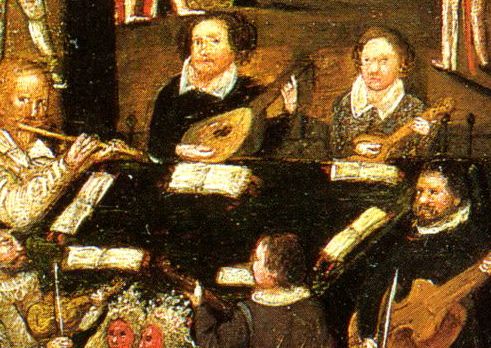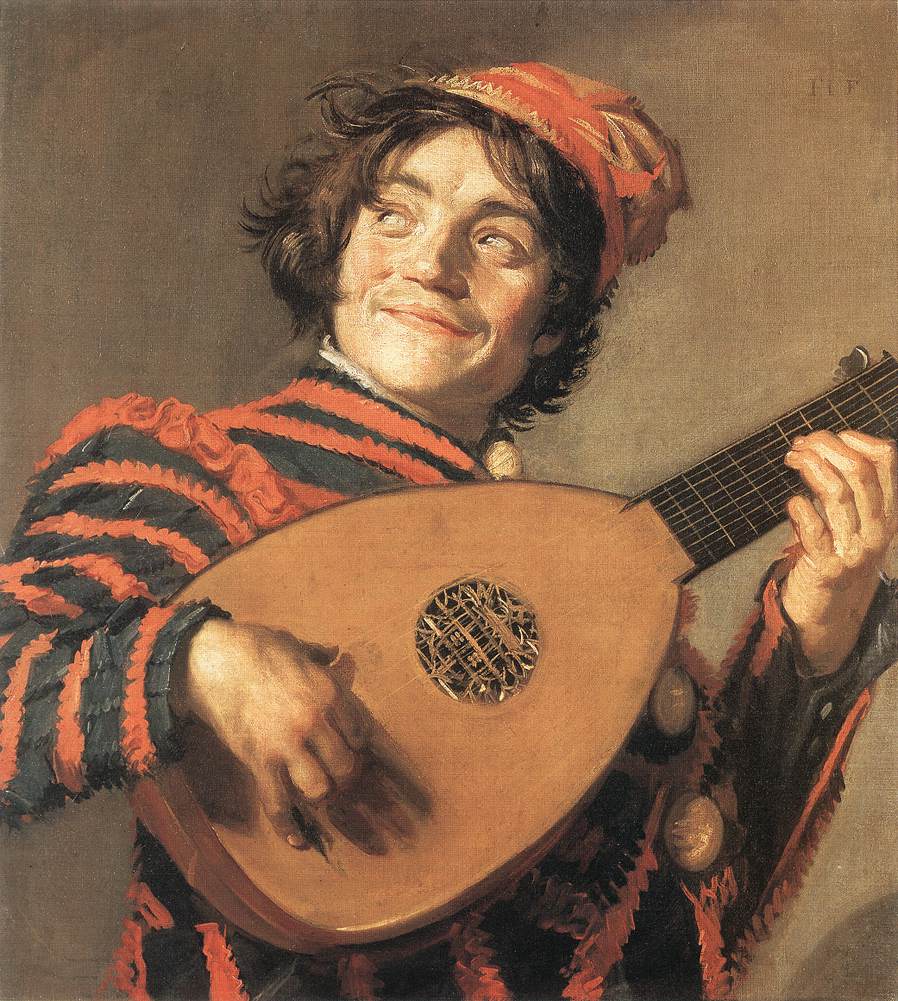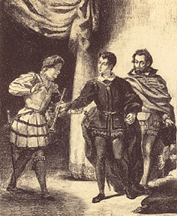The Baltimore Consort provides these notes about the music they will perform on their SFEMS concerts, taking place the weekend of November 20–22.
A note about our instruments
The Fairy Queen and her maides daunced about the garden, singing a Song of six parts, with the musick of an exquisite consort; wherein was the lute, bandora, base-violl, citterne, treble viol and flute.
—from The Honourable Entertainment at Elvetham, anon., 1591.

The “exquisite consort” that entertained Queen Elizabeth upon her visit to the Earl of Hertford in September 1591 was, in respect to the specific instruments employed, the exact equivalent of the Baltimore Consort. Referred to in modern times as a “mixed” or “broken” consort, this band enjoyed popularity in the Elizabethan and early Jacobean periods. Combining the sultry viols, the ethereal flute, the ‘sprightly and cheerful’ cittern, the ‘deep’ bandora and the ‘noble’ lute, the ensemble is capable of many moods, from the joyful to the melancholy. The Baltimore Consort will not be using a bandora in tonight’s concert; instead, we will provide additional instrumental color by including bagpipes, recorders, fifes, krummhorns, and a gemshorn.
Like the plays for which it often provided accompaniment, Elizabethan consort music, “reflected the remarkable synthesis of popular taste and humanist eloquence which gave vitality to the Shakespearean theatre” in appealing “to every level of spectator, from the simplest groundling who could hum along with his favorite ballad tune to the most sophisticated gallant who could take delight in the rich harmony and embroidery surrounding the melody” (from Sydney Beck’s introduction to his edition of Morley’s Consort Lessons).
A note about music in Shakespeare’s Plays
There are hundreds of references to music in the works of Shakespeare. Shakespeare’s music can be placed into three general categories.
Incidental Music: The individual titles of incidental music in Shakespeare’s works are never named but the directions “music here,” “music begins,” “music for dancing,” etc. are provided.
Literary References: Shakespeare refers to the music, music theory, and instruments of the time within the text of his works. A humorous example is found in the names of the musicians whom Peter confronts in Romeo and Juliet: Hugh Rebec, Simon Catling and James Soundpost.
Songs: Specific songs are included for performance in the text of Shakespeare’s plays. Shakespeare authored the lyrics to some of these songs but also incorporated popular songs known to his contemporary audiences. The plays did not include notation of the tunes of these songs. However, we are certain that Robert Johnson’s setting for Full Fathom Five is the same as when originally performed in The Tempest. Johnson is well documented as Shakespeare’s composer. For the other songs that you will hear tonight, we are using the earliest surviving versions—both published and from manuscript—which are contemporary with Shakespeare’s productions. These include, It was a Lover and His Lasse, When Griping Grief, Where the Bee Sucks, Heart’s Ease, In Youth When I Did Love, Full Fathon Five, Fortune My Foe, and The Willow Song.
Music in its Dramatic (or Comic) Context
As You Like It Will Kemp (or Kempe) was one of the great clowns in Shakespeare’s troupe and played Touchstone in As you Like It. He is also famous for his “Nine Day Wonder,” in which he danced all the way from London to Norwich, a distance of about a hundred miles. Kemp’s Jig may have been written to commemorate that spectacle, which drew multitudes of spectators.
In Act V, Touchstone requests that two pages sing a love song as he prepares to woo Audrey, a country wench. The pages respond with one of the most beloved songs from the entire Shakespeare canon, It was a Lover and his Lass, after which Touchstone promptly berates them for their unmusical rendition. This is one of only a few songs from the plays that survive in their original settings.
Twelfth Night Our music in this set comes chiefly from Act II, iii, in which the well-oiled Sir Toby Belch and Sir Andrew Aguecheek conspire with Feste the Clown and Maria to humiliate Olivia’s officious steward Malvolio. Andrew, despite the late hour, calls on Feste to sing a love song, O Mistress Mine. Our version tonight is not the song itself, but rather the beautiful consort setting by Thomas Morley.
A few lines late, Sir Toby Belch remarks, “My lady’s a Catayan, we are politicians. Malvolio’s a Peg-a-Ramsey, and three merry men be we.” (A Peg-a-Ramsey is a term of contempt, taken from a character in a folk ballad.)
Shortly thereafter, Malvolio enters and peremptorily requests that Sir Toby lower his voice and behave properly. Toby responds by loudly singing Farewell Dear Love, alternating verses with Feste.

The Buffens (The Clowns) is the English title for “Les Bouffons,” a French dance that crossed the channel into England. The tune is not referenced in the play, but we’ve programmed it here as a tribute to Feste and the two prominent Shakespearean clowns represented in this program—Will Kemp and Richard Tarleton.
Romeo and Juliet The scene between the Capulet’s servant Peter and the musicians following Juliet’s feigned death in Act IV creates an odd moment of comic relief. Peter sings, “When Griping Grief the heart doth wound, And doleful dumps the mind express, Then music with her silver sound With speedy help doth lend redress.” Shakespeare actually lifted this beautiful stanza from Richard Edwards’ The Paradyse of Dayntey Devices, and Edward’s song When Griping Grief is among the most poignant in all of Shakespeare.
A “dump” is by definition doleful—it is a melancholy, mournful air—and often contains a gently rocking two-chord accompaniment that invites solace and quiet contemplation. Lady Carey’s Dump is among the most famous in this genre.
When Peter first hears the news of Juliet’s supposed death, he calls for the musicians to play Heart’s Ease because “my heart is full of woe.” The ballad Complain My Lute, sung to the tune of Heart’s Ease, contains that line at the end of the first verse. But there is a second, more cheerful, tune with the name “Heart’s Ease.” This version, also known as The Honeysuckle, exists as an alman—a stately dance in duple meter—by Anthony Holborne
Henry IV, part 2 and A Winter’s Tale A single line by the loveable rogue Falstaff in Act III of Henry IV, part 2 provides us with the first two pieces of our set: “…the whores called him mandrake: he came ever in the rearward of the fashion, and sung those tunes to the overscutched housewives that he heard the Carmen whistle, and swore they were his fancies or his good-nights.” Our Fancy, for solo lute, is by John Dowland, arguably the greatest composer of the Elizabethan era, and certainly the most important and influential composer of lute music in history.
In the quote above, Falstaff references the ballad Carman’s Whistle, one of the countless “euphemism” broadsides in which a canny young lad seduces an innocent maid, to her distinct pleasure, as is evidenced by her final verse, “Let other maids say what they will/The truth of all is so/The bonny Carman’s whistle/Shall for my money go.”
We close the first half with a medley of two tunes from Act IV of Winter’s Tale; the first, Whoope, do me no harm is a lusty song quoted by a servant, and the second, Jog On, a cheery ditty sung by the rogue Autolycus to close the third scene: “Jog on, jog on, the footpath way/And merrily hent the style-a/A merry heart goes all the day/Your sad tires in a mile-a.

Hamlet “Christianus the fourth, King of Denmarke, his galliard” is the full title of Dowland’s tribute to his employer. The piece was published in “Varietie of Lute Lessons” by his son Robert Dowland, in 1610, and makes for the perfect introduction to this set. Our arrangement is based on the five-part version in the 1604 publication “Lachrymae.” Though not a “musical” play Hamlet nonetheless does have tunes sung by Ophelia as she lapses into madness (e.g. Bonny sweet robin) and the wonderful Gravedigger’s Song. The other tunes reference Richard Tarleton, a favorite comic actor of Shakespeare, who may even have memorialized him in the play with the nickname “Yorick.”
The Tempest The Tempest is one of Shakespeare’s late plays and possibly the last he wrote alone. Robert Johnson was Shakespeare’s collaborator, or composer-in-residence in the King’s Men and contributed two songs to the play. Full fathom five (Act I, scene ii) is sung by the invisible fairy Ariel, to lure Ferdinand, the Prince of Naples, to Prospero and his daughter Miranda. Where the bee sucks (Act V, scene i) is also sung by Ariel to entertain Prospero while he is dressing. We include, as “incidental” music to this set John Johnson’s setting of Greensleeves (John was the father of Robert Johnson) and the ballad tune Loth to Depart, set by Dowland. The phrase “loath to go” or “loath to leave” appears in Comedy of Errors, Cymbeline, and Merchant of Venice. Greensleeves was actually mentioned by Falstaff in Merry Wives of Windsor (II, i) as he bellows: “Let the sky rain potatoes; let it thunder to the tune of Greensleeves!”
Merry Wives of Windsor and Othello When Falstaff remarks In Act III of Merry Wives of Windsor, “I see what thou wert, if Fortune thy foe, were not Nature thy friend,” he is referring to the very popular ballad Fortune My Foe, which was arranged by many Elizabethan composers, including John Dowland and Thomas Morley. The tune itself was a popular choice to be sung to prisoners as they were led to their executions, hence the mournful quality to our rendition. The Willow Song (“Willow, Willow”), perhaps Shakespeare’s most heartbreakingly poignant song. is sung by Desdemona to her maid Emilia shortly before her death at the hands of Othello. The original tune predates the play; it comes from the Lodge Lute Book, printed in 1559.
A Midsummer Night’s Dream We end our program tonight in the magical realm of spirits and fairies that Shakespeare conjures up for us in Midsummer Night’s Dream. Holborne’s Fairie Rownd is one of many sprightly dances by Elizabethan composers that evokes the enchantment of the supernatural world.
Robin Goodfellow is “the shrewd and knavish sprite” who also goes by the name of Puck. In The Mad Merry Pranks of Robin Goodfellow, we meet our old familiar mischievous sprite, who plays tricks on unsuspecting mortals for the sheer pleasure of the sport. Our text comes from a 17th-century broadside, to a tune widely known as “Robin Goodfellow.”












